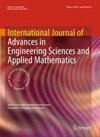利用绿色合成方法对环境中重金属进行纳米生物修复
IF 0.8
Q3 ENGINEERING, MULTIDISCIPLINARY
International Journal of Advances in Engineering Sciences and Applied Mathematics
Pub Date : 2023-03-01
DOI:10.11591/ijaas.v12.i1.pp7-14
引用次数: 0
摘要
由于有毒重金属在空气、水和土壤中的浓度增加,直接与生命相互作用,人类的生活质量受到损害。铬、镉、铜、砷、锌、铅、汞超标,不仅对人体造成损害,而且对动物、植物和微生物也有很大影响。传统方法的弊端不断增加,使其成为重金属修复的不良选择。相比之下,在纳米水平上使用先进技术会产生有希望的结果。许多纳米材料,如碳纳米管、纳米纤维、纳米花和不同金属的纳米吸附剂,如铜、钛、锌、金、银、铁、铈和锰,与不同的生物材料一起使用,提高了科学领域的纳米生物修复率,并提出了工业和环境应用。作为具有成本效益、生态友好、可控性质的纳米生物修复技术,它们缺乏背景知识,并且在商业层面处理。本文综述了不同类型的纳米材料,它们如何在不同的应用中实现,它们的绿色合成方法,以及实时使用纳米生物修复技术的利与弊。本文章由计算机程序翻译,如有差异,请以英文原文为准。
Nano-bioremediation of heavy metals from environment using a green synthesis approach
The quality of human life is compromised due to the increased concentration of toxic heavy metals in air, water, and soil which is directly interacted with living life. Exceed levels of Cr, Cd, Cu, As, Zn, Pb, and Hg influence the living chain and not only causes human damage but also greatly effects animals, plants, and microorganisms. The consistent increase in drawbacks of traditional methods makes them a poor choice for the remediation of heavy metals. In comparison to that, the use of advanced technology at nano levels gives promising results. Many nanomaterials such as carbon nanotubes, nanofibers, nanoflowers, and nanoadsorbents of different metals such as copper, titanium, zinc, gold, silver, iron, cerium, and manganese use along with different biological materials increase the nano-bioremediation rate in the field of science and pose industrial and environmental applications. Being a cost-effective, eco-friendly, controllable nature of nano-bioremediation technology, they lack background knowledge, and handling at the commercial level. This review highlights different types of nanomaterials, how they are implemented in different application, their green synthesis approach, and the boon and bane of using nano-bioremediation technology in real-time.
求助全文
通过发布文献求助,成功后即可免费获取论文全文。
去求助
来源期刊

International Journal of Advances in Engineering Sciences and Applied Mathematics
ENGINEERING, MULTIDISCIPLINARY-
自引率
0.00%
发文量
6
期刊介绍:
International Journal of Advances in Engineering Sciences and Applied Mathematics will be a thematic journal, where each issue will be dedicated to a specific area of engineering and applied mathematics. The journal will accept original articles and will also publish review article that summarize the state of the art and provide a perspective on areas of current research interest.Articles that contain purely theoretical results are discouraged.
 求助内容:
求助内容: 应助结果提醒方式:
应助结果提醒方式:


